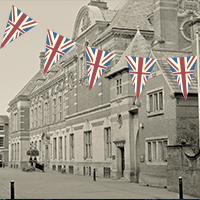County Buildings, Stafford

History of the building
The buildings were designed by an emerging young architect, Henry Hare and opened in October 1895. Henry won £150 in a competition in 1892 to design the new council hall in which County Councillors could meet, and which could provide accommodation for the council’s officials. The Council had specified that the building should provide 'good, thoroughly business-like offices'.
Henry went on to become President of the Architectural Society in 1902 and President of the Royal Institute of British Architects 1917–19. His trademark is an etching or carving of a hare which he apparently included in every building he designed.
It took two years for Henry Lovatt, a respected building firm from Wolverhampton (then still in Staffordshire), to build the hall which was the first public building to be completely lit by electricity. This was unusual at the time as most public buildings were still lit by gas. And the build was certainly ahead of its time. The council chamber benefitted from an ice based air conditioning system for which the workings are still visible today. By contrast it wasn’t until 1929 that the White House had the new-fangled electric air conditioning installed, and that only worked until 1934.
One of the many spectacular features of the building is the 12 foot wide staircase, built from Hopton Wood Limestone with an Oak gallery running around three sides. This type of limestone, quarried in Middleton, Derbyshire, is of particularly fine quality and has a marble-like appearance. It’s used in The Houses of Parliament and Westminster Abbey so it is in good company.
Within the main domed Chamber there are four large relief panels created by the sculptor Frederick Emil Eberhard Schneck. The panels depict the main Staffordshire industries of the time: pottery, ironwork, mining and agriculture. Stafford was the first in a series of his collaborations with architect Henry Hare on other municipal buildings.
The Members Library was added in a second phase of building in 1900 and 1902.
Over the past century, we have amassed a large collection of paintings and prints. The majority of them were collected before 1932, when the first inventory was compiled by the then Clerk, Eustace Joy. Many of the prints and pictures were purchased through the County Council’s Picture Fund established as a separate fund for this purpose.
There are 32 oil paintings in the collection; all are portraits of local dignitaries and aristocrats, with the earliest, of Sir Richard Bagot, dating from the late 16th century. There is also a significant collection of early printed maps of Staffordshire, and prints of portraits of prominent Staffordshire nobility and officials.
The majority of items are on display. Others are in store or hanging in the adjoining Judges’ Lodgings. The collection can be viewed online on the Staffs Past Track website.